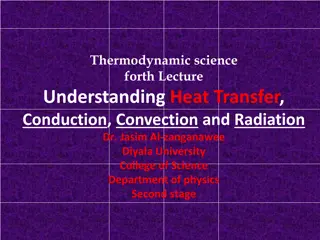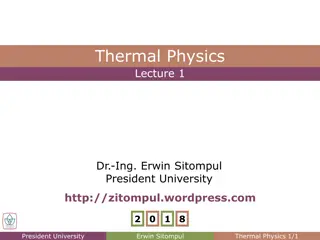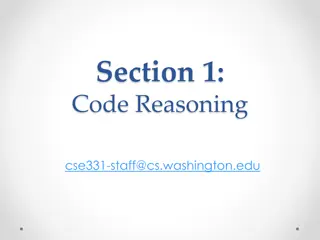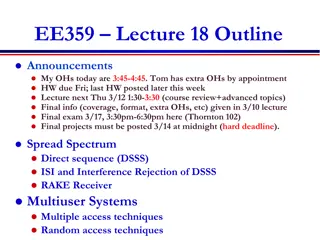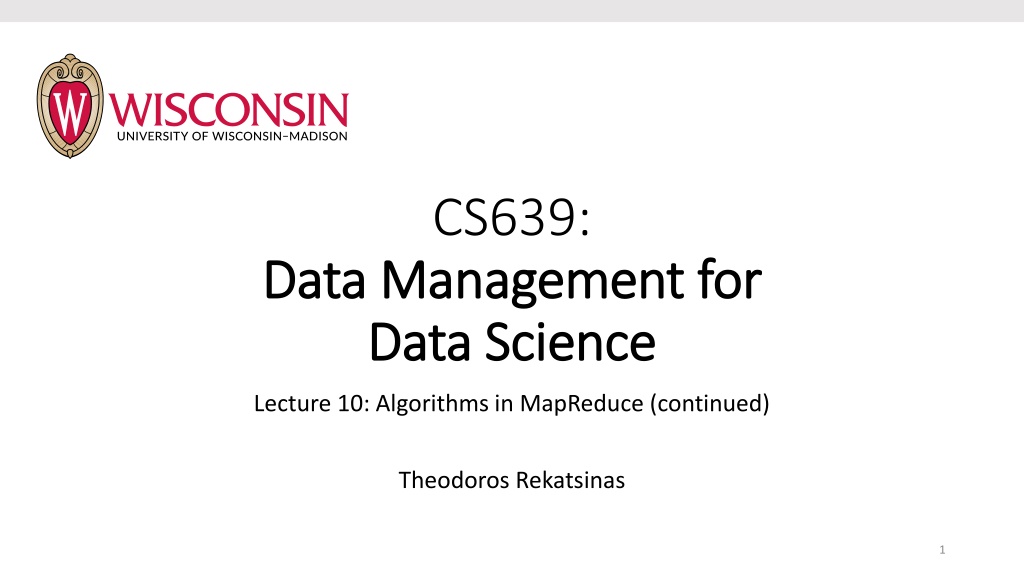
Algorithms in MapReduce: Recap and Examples
Explore MapReduce data and programming models, understand the distributed algorithms involved, and delve into practical examples like word count over document corpora. Get ready to boost your data management skills with this insightful lecture.
Download Presentation

Please find below an Image/Link to download the presentation.
The content on the website is provided AS IS for your information and personal use only. It may not be sold, licensed, or shared on other websites without obtaining consent from the author. If you encounter any issues during the download, it is possible that the publisher has removed the file from their server.
You are allowed to download the files provided on this website for personal or commercial use, subject to the condition that they are used lawfully. All files are the property of their respective owners.
The content on the website is provided AS IS for your information and personal use only. It may not be sold, licensed, or shared on other websites without obtaining consent from the author.
E N D
Presentation Transcript
CS639: Data Management for Data Management for Data Science Data Science Lecture 10: Algorithms in MapReduce (continued) Theodoros Rekatsinas 1
Logistics/Announcements PA3 out by the end of day If you have grading questions or questions for PA1 and PA2 please ask Frank and Huawei No class on Monday, we will resume on Wednesday 2
Todays Lecture 1. Recap on MapReduce data and programming model 2. More MapReduce Examples 3
1. Recap on MapReduce data and programming model 4
Recall: The Map Reduce Abstraction for Distributed Algorithms Distributed Data Storage map map map map map map Map (Shuffle) Reduce reduce reduce reduce reduce
Recall: MapReduces Data Model Files! A File is a bag of (key, value) pairs A bag is a multiset A map-reduce program: Input: a bag of (inputkey, value) pairs Output: a bag of (outputkey, value) pairs
MapReduce Programming Model Input & Output: each a set of key/value pairs Programmer specifies two functions: map (in_key, in_value) -> list(out_key, intermediate_value) Processes input key/value pair reduce (out_key, list(intermediate_value)) -> (out_key, list(out_values)) Combines all intermediate values for a particular key Produces a set of merged output values (usually just one) Produces set of intermediate pairs
Example: Word count over a corpus of documents map(String input_key, String input_value): //input_key: document id //input_value: document bag of words for each word w in input_value: EmitIntermediate(w, 1); reduce(String intermediate_key, Iterator intermediate_values): //intermediate_key: word //intermediate_values: ???? result = 0; for each v in intermediate_values: result += v; EmitFinal(intermediate_key, result);
Relational Join Assigned Departments Employee EmpSSN DepName Name SSN 9999999999 Accounts Sue 9999999999 7777777777 Sales Tony 7777777777 7777777777 Marketing Employee SSN=EmpSSN Assigned Departments Name SSN EmpSSN DepName Sue 9999999999 9999999999 Accounts Tony 7777777777 7777777777 Sales Tony 7777777777 7777777777 Marketing
Relational Join Assigned Departments Employee EmpSSN DepName Name SSN 9999999999 Accounts Sue 9999999999 Remember the semantics! 7777777777 Sales Tony 7777777777 7777777777 Marketing join_result = [] for e in Employee: for d in Assigned Departments: if e.SSN = d.EmpSSN r = <e.Name, e.SSN, d.EmpSSN, d.DepName> join_result.append(r) rerun join_result Employee SSN=EmpSSN Assigned Departments Name SSN EmpSSN DepName Sue 9999999999 9999999999 Accounts Tony 7777777777 7777777777 Sales Tony 7777777777 7777777777 Marketing
Relational Join Assigned Departments Employee EmpSSN DepName Name SSN 9999999999 Accounts Sue 9999999999 Remember the semantics! 7777777777 Sales Tony 7777777777 7777777777 Marketing join_result = [] for e in Employee: for d in Assigned Departments: if e.SSN = d.EmpSSN r = <e.Name, e.SSN, d.EmpSSN, d.DepName> join_result.append(r) rerun join_result Employee SSN=EmpSSN Assigned Departments Imagine we have a huge number of records! Let s use MapReduce! We want the map phase to process each tuple. Is there a problem? Name SSN EmpSSN DepName Sue 9999999999 9999999999 Accounts Tony 7777777777 7777777777 Sales Tony 7777777777 7777777777 Marketing
Relational Join Assigned Departments Employee EmpSSN DepName Name SSN 9999999999 Accounts Sue 9999999999 Remember the semantics! 7777777777 Sales Tony 7777777777 7777777777 Marketing join_result = [] for e in Employee: for d in Assigned Departments: if e.SSN = d.EmpSSN r = <e.Name, e.SSN, d.EmpSSN, d.DepName> join_result.append(r) rerun join_result Employee SSN=EmpSSN Assigned Departments Imagine we have a huge number of records! Let s use MapReduce! We want the map phase to process each tuple. Is there a problem? Name SSN EmpSSN DepName Sue 9999999999 9999999999 Accounts Tony 7777777777 7777777777 Sales The Relational Join is a binary operation! But MapReduce is a unary operation: I operate on a single key Tony 7777777777 7777777777 Marketing Can we approximate the join using MapReduce?
Relational Join in MapReduce: Preprocessing before the Map Phase Employee Key idea: Flatten all tables and combine tuples from different tables in a single dataset Name SSN Sue 9999999999 Employee Sue 9999999999 Tony 7777777777 Employee Tony 7777777777 Assigned Departments 9999999999 Accounts Assigned Departments EmpSSN DepName Assigned Departments 7777777777 Sales 9999999999 Accounts Assigned Departments 7777777777 Marketing 7777777777 Sales 7777777777 Marketing
Relational Join in MapReduce: Preprocessing before the Map Phase Employee Key idea: Flatten all tables and combine tuples from different tables in a single dataset Name SSN Sue 9999999999 Employee Sue 9999999999 Tony 7777777777 Employee Tony 7777777777 Assigned Departments 9999999999 Accounts Assigned Departments EmpSSN DepName Assigned Departments 7777777777 Sales 9999999999 Accounts Assigned Departments 7777777777 Marketing 7777777777 Sales 7777777777 Marketing We use the table name to keep track of which table did the tuple come from This is a label that we've attached to every tuple so that we can know where that came from. We'll use it later!
Relational Join in MapReduce: Map Phase Employee Sue 9999999999 Employee Tony 7777777777 Assigned Departments 9999999999 Accounts Assigned Departments 7777777777 Sales Assigned Departments 7777777777 Marketing For each tuple in the flattened input we will generate a key value pair! key=9999999999, value=(Employee, Sue, 9999999999) key=7777777777, value=(Employee, Tony, 7777777777) key=9999999999, value=(Assigned Departments, 9999999999, Accounts) key=7777777777, value=(Assigned Departments, 7777777777, Sales) key=7777777777, value=(Assigned Departments, 7777777777, Marketing)
Relational Join in MapReduce: Map Phase Employee Sue 9999999999 Employee Tony 7777777777 Assigned Departments 9999999999 Accounts Assigned Departments 7777777777 Sales Assigned Departments 7777777777 Marketing Why use this value as the key? For each tuple in the flattened input we will generate a key value pair! key=9999999999, value=(Employee, Sue, 9999999999) key=7777777777, value=(Employee, Tony, 7777777777) key=9999999999, value=(Assigned Departments, 9999999999, Accounts) key=7777777777, value=(Assigned Departments, 7777777777, Sales) key=7777777777, value=(Assigned Departments, 7777777777, Marketing)
Relational Join in MapReduce: Map Phase Employee Sue 9999999999 Employee Tony 7777777777 Assigned Departments 9999999999 Accounts Assigned Departments 7777777777 Sales Assigned Departments 7777777777 Marketing Why use this value as the key? We are joining on SSN (for Employee) and EmpSSN (for Assigned Depts) For each tuple in the flattened input we will generate a key value pair! key=9999999999, value=(Employee, Sue, 9999999999) key=7777777777, value=(Employee, Tony, 7777777777) key=9999999999, value=(Assigned Departments, 9999999999, Accounts) key=7777777777, value=(Assigned Departments, 7777777777, Sales) key=7777777777, value=(Assigned Departments, 7777777777, Marketing)
Relational Join in MapReduce: Map Phase (Two Tricks so far) (Two Tricks so far) Employee Sue 9999999999 Employee Tony 7777777777 Assigned Departments 9999999999 Accounts Trick 1: Flattened and combined tables in a single input file. Assigned Departments 7777777777 Sales Assigned Departments 7777777777 Marketing Why use this value as the key? We are joining on SSN (for Employee) and EmpSSN (for Assigned Depts) For each tuple in the flattened input we will generate a key value pair! Trick 2: Produce a key value pair where the key is the join attribute. key=9999999999, value=(Employee, Sue, 9999999999) key=7777777777, value=(Employee, Tony, 7777777777) key=9999999999, value=(Assigned Departments, 9999999999, Accounts) key=7777777777, value=(Assigned Departments, 7777777777, Sales) key=7777777777, value=(Assigned Departments, 7777777777, Marketing)
Relational Join in MapReduce: Reduce Phase (after the magic Shuffle) Input to Reducer 1 key=9999999999, value=[(Employee, Sue, 9999999999), (Assigned Departments, 9999999999, Accounts)] After the shuffle phase all inputs with the same key will end up in the same reducer! Input to Reducer 2 key=7777777777, value=[(Employee, Tony, 7777777777), (Assigned Departments, 7777777777, Sales), (Assigned Departments, 7777777777, Marketing)] It does not matter which relation the different tuples came from!
Relational Join in MapReduce: Reduce Phase (after the magic Shuffle) Input to Reducer 1 key=9999999999, value=[(Employee, Sue, 9999999999), (Assigned Departments, 9999999999, Accounts)] We have all the information we need to perform the join for a each key in a single machine. Input to Reducer 2 key=7777777777, value=[(Employee, Tony, 7777777777), (Assigned Departments, 7777777777, Sales), (Assigned Departments, 7777777777, Marketing)] This is how we scale.
Relational Join in MapReduce: Reduce Phase (after the magic Shuffle) Desired output of reduce function Input to Reducer 1 key=9999999999, value=[(Employee, Sue, 9999999999), (Assigned Departments, 9999999999, Accounts)] Output of Reduce Function (Reducer 1) Sue, 9999999999, 9999999999, Accounts Output of Reduce Function (Reducer 2) Tony, 7777777777, 7777777777, Sales Tony, 7777777777, 7777777777, Marketing Input to Reducer 2 key=7777777777, value=[(Employee, Tony, 7777777777), (Assigned Departments, 7777777777, Sales), (Assigned Departments, 7777777777, Marketing)]
Relational Join in MapReduce: Reduce Phase (after the magic Shuffle) Desired output of reduce function Input to Reducer 1 key=9999999999, value=[(Employee, Sue, 9999999999), (Assigned Departments, 9999999999, Accounts)] Output of Reduce Function (Reducer 1) Sue, 9999999999, 9999999999, Accounts Output of Reduce Function (Reducer 2) Tony, 7777777777, 7777777777, Sales Tony, 7777777777, 7777777777, Marketing Input to Reducer 2 key=7777777777, value=[(Employee, Tony, 7777777777), (Assigned Departments, 7777777777, Sales), (Assigned Departments, 7777777777, Marketing)] This part came from the Employees table This part came from the Assigned Departments table What is the reduce function implementation?
Relational Join in MapReduce: Reduce Phase Implementation Input to Reducer 1 key=9999999999, value=[(Employee, Sue, 9999999999), (Assigned Departments, 9999999999, Accounts)] Desired output of reduce function Output of Reduce Function (Reducer 1) Sue, 9999999999, 9999999999, Accounts Output of Reduce Function (Reducer 2) Tony, 7777777777, 7777777777, Sales Tony, 7777777777, 7777777777, Marketing Input to Reducer 2 key=7777777777, value=[(Employee, Tony, 7777777777), (Assigned Departments, 7777777777, Sales), (Assigned Departments, 7777777777, Marketing)] Simple Pseudo-code for Reduce reduce(String key, Iterator tuples): //intermediate_key: join key //intermediate_values: tuples with the same join key join_result = []; for t1 in tuples: for t2 in tuples: if t1[0] <> t2[0]: output tuple = (t1[1:], t2[1:]) join_result.append(t) rerun (key, join_result) This is a cross-product operation! Relational algebra is everywhere! Notice that we need to keep track of where each tuple came from.
Social Network Analysis: Count Friends Input Desired Output Jim Sue Sue Jim Jim, 3 Lin, 2 Sue, 1 Kai, 1 Joe, 1 Lin Joe Joe Lin Jim Kai Kai Jim Jim Lin Lin Jim Symmetric friendship edges
Social Network Analysis: Count Friends Input Desired Output Jim Sue key, value Jim, 1 Sue, 1 Lin, 1 Joe, 1 Jim, 1 Kai, 1 Jim, 1 Lin, 1 Sue Jim Jim, 3 Lin, 2 Sue, 1 Kai, 1 Joe, 1 Lin Joe Jim, (1, 1, 1) Sue, 1 Lin, (1,1) Joe, 1 Kai, 1 Joe Lin MAP SHUFFLE REDUCE Jim Kai Kai Jim Jim Lin Lin Jim Emit one for each left-hand value Symmetric friendship edges
Matrix Multiply in MapReduce C = A x B A dimensions m x n, B dimensions n x l In the map phase: for each element (i,j) of A, emit ((i,k),A[i,j]) for k in 1..l Key = (i,k) and value = A[i,j] for each element (i,j) of B, emit ((i,k),B[i,j]) for k in 1..m Key = (i,k) and value = B[i,j] In the reduce phase, emit key = (i,k) Value = Sumj (A[i,j] * B[j,k])
Matrix Multiply in MapReduce: Illustrated x = We have one reducer per output cell Each reducer computes Sumj (A[i,j] * B[j,k])







